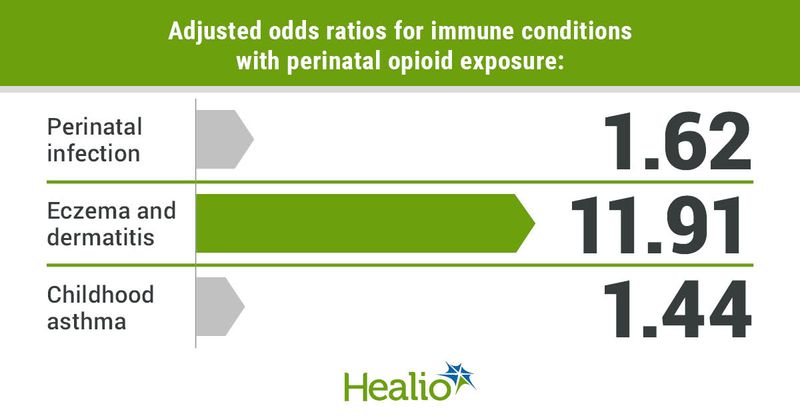Prenatal opioid exposure associated with eczema, dermatitis, asthma
Key takeaways:
- Associations varied for exposures due to treatment for pain or for opioid use disorder.
- Neonatal abstinence syndrome drove greater associations with perinatal infection, eczema and dermatitis.
Children who were exposed to opioids prenatally faced greater risks for infection, eczema and dermatitis, and asthma, but not for allergies, anaphylaxis or autoimmune diseases, according to a study published in JAMA Network Open.
These findings indicate that such exposure may modify developing immune systems, Erin Kelty, PhD, research fellow, School of Population and Global Health, University of Western Australia, and colleagues wrote.

Results from previous research conducted by coauthor Lauren L. Jantzie, PhD, associate professor, division of neonatal-perinatal medicine, department of pediatrics, Johns Hopkins University School of Medicine, and her colleagues prompted this study.
“In rodent models, they had observed that prenatal opioid exposure was altering the immune system,” Kelty told Healio.
The retrospective cohort study included all live-born children (n = 401,462) who were born in Western Australia between Jan. 1, 2003, and Dec. 31, 2018, with a minimum follow-up of 1.5 years and a mean follow-up of 4.9 years.
The cohort included 1,656 children with prenatal opioid exposure (POE; 0.4%; mean gestational age, 37.7 weeks; 50.5% girls) and 399,806 who did not have POE (99.6%; mean gestational age, 38.6 weeks; 48.7% girls).
The POE group included 1,172 (70.8%) exposed during the first trimester, 1,220 (73.7%) exposed during the second trimester and 1,265 (76.4%) exposed during the third trimester. Also, 666 (40.2%) were diagnosed with neonatal abstinence syndrome (NAS).
POE was associated with opioids used to treat pain for 679 (41%) of these children and to treat opioid use disorder (OUD) for 1,007 (60.8%) of these children.
There also was an association between POE and increased risk for perinatal infection, with an adjusted odds ratio of 1.62 (95% CI, 1.38-1.9). The adjusted odds ratio increased to 2.91 (95% CI, 2.36-3.57) for children with POE and NAS.
Perinatal eczema and dermatitis were associated with POE as well (aOR = 11.91; 95% CI, 9.84-14.41), with a greater association among neonates with POE and NAS (aOR = 31.11; 95% CI, 24.64-39.28).
The perinatal eczema and dermatitis cases included 2,188 (87.7%) neonates with diaper dermatitis and 256 (10.3%) with erythema intertrigo.
Adjusted odds ratios for diaper dermatitis included 3.54 (95% CI, 2.71-4.61) with POE and 6.66 (95% CI, 5.24-8.47) with NAS. Similarly, adjusted odds ratios for erythema intertrigo included 3.15 (95% CI, 1.55-6.4) for POE and 4.97 (95% CI, 2.57-9.6) for NAS.
Children with POE faced increased risks for hospitalization and/or ED visits due to asthma with an adjusted hazard ratio of 1.44 (95% CI, 1.16-1.79) compared with children who did not have POE.
The risks for hospitalization and/or ED visits due to eczema and dermatitis increased for children with POE as well, with an adjusted hazard ratio of 1.35 (95% CI, 1.05-1.74), although the researchers noted that this risk increased for children who were exposed to opioids used to treat OUD (aHR = 1.47; 95% CI, 1.08-1.99) but not to treat pain.
Also, there was no increased risk for hospitalization or ED visits due to allergies or anaphylaxis for children with POE compared with children who did not have POE.
“We were interested to see that while prenatal opioid exposure was associated with an increase in eczema and infections, there was no such association with allergies and anaphylaxis,” Kelty said.
The researchers further said there were modest increases in risks for infection with POE overall and by the trimester of exposure, ranging from 8% to 18%. Risks increased by 45% (aHR = 1.44; 95% CI, 1.32-1.58) for opioids used to treat pain and by 4% (aHR = 1.04; 95% CI, 0.96-1.12) for opioids used to treat OUD.
Associations between POE and infection varied by type of infection, including increased risks for enteric infections, neurologic and eye infections, upper and lower respiratory tract infections, digestive tract infections, skin and soft tissue infections, and other infections.
Adjustments for maternal age, child sex, cesarean delivery, smoking status during pregnancy and preterm birth, however, limited these associations to enteric, lower respiratory tract and other infections.
Additional analysis found no increased risks for specific infections with POE resulting from OUD treatment, the researchers continued, but POE resulting from pain treatment was associated with increased risks for enteric infections, neurological and eye infections and upper and lower respiratory tract infections, and other infections.
Analysis also found no association between POE and increased risks for autoimmune conditions, the researchers continued, although they also said that these conditions were not common in the cohort.
Specifically, fewer than five children (< 0.3%) in the POE group and 1,335 (0.3%) in the group without POE were hospitalized or had visited the ED before age 5 years because of an autoimmune disease.
Based on these findings, the researchers concluded that there were associations between POE and increases in hospitalizations and ED visits for conditions related to immunity, suggesting that POE may modify the immune system and impact how it reacts to subsequent conditions.
“The study highlights that prenatal opioid exposure may impact a child’s health beyond the neonatal period,” Kelty said.
However, Kelty continued, these findings are just a small consideration in an otherwise complex and individualistic decision as to the use of opioids in pregnancy. She and her colleagues would like to continue their investigations.
“We would like to look at differences between prenatal exposures to individual medications in their association with immune related conditions, to see if there are medications that have more or less impact on the developing immune system,” she said.
For more information:
Erin Kelty, PhD, can be reached at erin.kelty@uwa.edu.au.
